 Brian Howenstein is an athletic player who struggles with consistency due to some bad habits he’s developed at the start of his golf swing. He is a young player who just graduated from college. Brian has been playing golf on and off since his sophomore year in high school.
Brian Howenstein is an athletic player who struggles with consistency due to some bad habits he’s developed at the start of his golf swing. He is a young player who just graduated from college. Brian has been playing golf on and off since his sophomore year in high school.
Brian’s misses tend to be to the right in the form of large fades or giant slices. He hits his driver around 275 yards, but admits that number varies considerably depending on how he is playing that day. His 5-iron is his 200-yard club, which tells me he must hit his irons better than his driver. Lately Brian has been working on his swing path, keeping his head still, and shifting his weight to his left side, all of which can be good aspects of the swing to work on. But as we dissect his swing, we will find out some of these are not his main problems.
On a positive note, Brian has a lot to work with. He has a very athletic movement around which it will be easy to build a good, repeatable golf swing. As a former baseball player, he possesses some important facets of a good golfer, including good hand-eye coordination and general athleticism.
So without wasting any more time lets take a look at Brian’s swing.
Setup
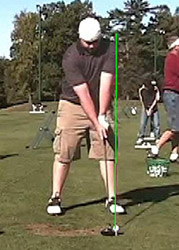 For the most part, Brian sets up to the ball pretty well. He is square to his target line, his spine angle is good, and he lets his hands hang freely from his shoulders without reaching or holding the club close to his body. The only thing he could improve on would be to get into a slightly more athletic position by bending the knees a bit more.
For the most part, Brian sets up to the ball pretty well. He is square to his target line, his spine angle is good, and he lets his hands hang freely from his shoulders without reaching or holding the club close to his body. The only thing he could improve on would be to get into a slightly more athletic position by bending the knees a bit more.
From the face-on view you can see his ball position is good in relation to both his front foot and the center of his body. His right-hand grip is in a good neutral position, his spine is tilted slightly to his right and his head is in a good position behind the ball. From this position he is ready to begin a good golf swing.
Takeaway
The takeaway is the beginning of what is wrong with Brian’s golf swing. As we can see in the picture, he makes the mistake we see in lots of high-handicap players: he takes the club back way too far to the inside. From this inside position he easily gets “stuck.” Many of the problems that occur from this point on in his swing are essentially because of his initial takeaway.
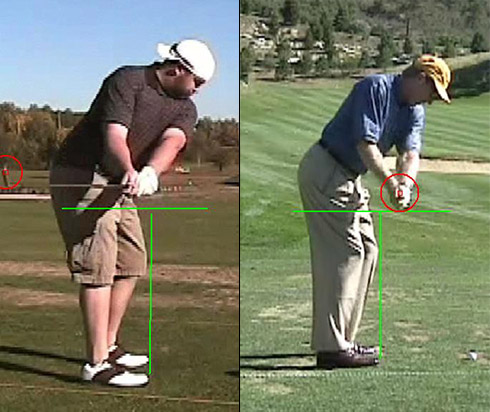
Brian starts the club back way to the inside as compared to PGA Tour pro Grant Waite. From this inside position Brian is unable to get the club back into a proper position to make consistant contact.
Brian needs to get in a position on the takeaway more like PGA tour pro Grant Waite. I have drawn lines to show the position of their clubheads in relation to their hands and bodies. Notice how Grant keeps his club out in front of his body on takeaway. Brian has flipped his clubhead way to the inside. Because of this initial move it becomes very difficult to get the club back on plane.
From the front Brian has a good one piece takeaway, he just needs to work on getting the club on a path more to the outside of his body. A good drill for this would be to set a 2-by-4 down just outside of the ball and parallel to the target line. When taking the club back, make sure for the first few inches that the toe of the club stays in contact with the board. This will force you to start the club head on the correct line.
Backswing and Position at the Top
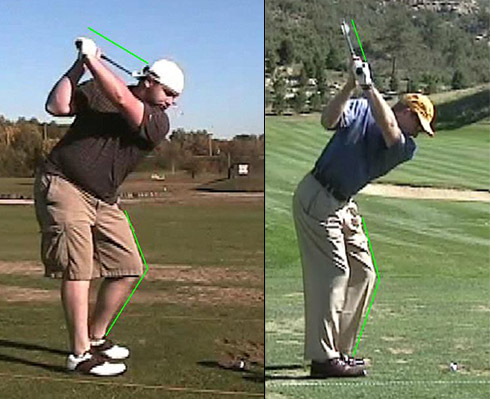
Brian’s club points well to the right at the top of the backswing.
From the takeaway, Brian’s club continues to wrap around his body until he gets to the top of his backswing where he points the shaft well right of his target line. The position at the top of the swing should look more like Grant Waite’s. Notice how Grant’s shaft is pointing at his target and he has not crossed parallel at the top. You can also see how he has to manipulate his clubhead to a much lesser extent than Brian does in order to get it back to square at impact.
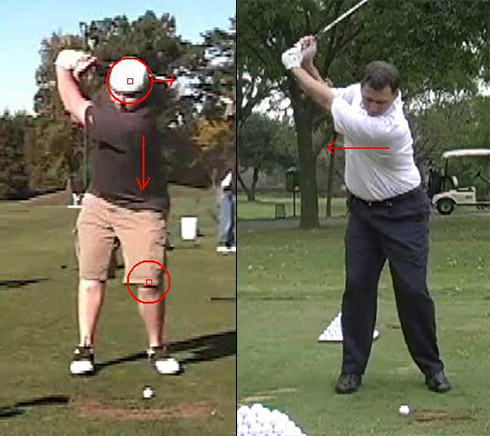
Brian collapses on his left side. In order to avoid this he needs to load more weight onto his right leg during the backswing.
From face on we can see another fault in Brian’s swing. He has said he is working on shifting his weight to his left side. That is not the problem. The problem is he never loads the weight on his right side in the first place. This lack of shift means there is too much of his weight on his left side during the back swing. When this happens, you’ll often finish in what’s called the “Reverse C” position. You can see in the picture how Brian’s left knee is collapsing and his upper body and head will make a move to his left. This decreases Brian’s coil and zaps the power from his swing. It also makes his head and shoulders move vertically, causing inconsistant ballstriking. Brian has to stabilize his left knee on the backswing and gain balance.
Notice the other image of the coil of PGA teaching pro John Lanham. You can see how he coils on his right side. This position helps his lower body stay stable and his upper body “gather” at the top of his swing. This, in turn, causes an increase in clubhead speed and more consistent ballstriking.
Downswing and Follow-Through
Brian makes a good recovery on his downswing, showing off his athleticism. The problem with having to make these recoveries is that it makes it very difficult to be consistent each swing. One shot Brian may be able to square the clubface and on the next he may leave it wide open. First, we notice Brian is able to get the club back on plane pretty well. The problem is the plane is too flat. A more upright swing plane would be desirable and very well might happen on its own when Brian fixes his takeaway.
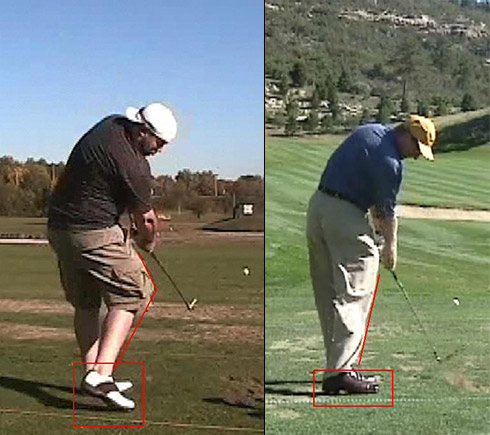
Brian’s right knee fires toward the target. A quieter lower body and more stable base is needed in order to help square the clubface more consistantly.
Next, we see the problems caused by his collapsing left side. Because of his unstable lower body he is unable to correctly clear his left side. The result is he is not able to square the clubface and he has a slight out-to-in swing path. To compensate for his left side, you can see in the pictures Brian’s right knee explodes towards his target line and he releases the clubhead early or casts, both of which will cost him power. Once Brian shores up his left side and stabilizes his base, he will need to learn to rotate his hips better and quiet his legs.
In contrast, you can see in Grant Waite’s swing how his lower body is quiet and he clears his left side correctly by rotating through. Notice how Grant’s right foot remains on the ground while Brian’s foot is on his right toe.
Brian’s follow-through, again like his takeaway, wraps around his body. This is not a major swing flaw and like many other aspects of Brian’s swing will work itself out with a little practice on the fundamentals.
In Conclusion
I can sum up Brian Howenstein’s golf swing with one word: potential. Brian’s problems are largely caused by a poor takeaway and a overly active lower body. With some work at the beginning of the swing plane and creating a solid base his swing is capable of much lower scores.
I would like to thank Bill Harvey, Head Golf Professional at Arroyo Del Oso golf course in Albuquerque, NM for his valuable contributions and insights with this article. If you too would like to submit a video of your swing for The Sand Trap‘s Swing Check please contact me at swingcheck@thesandtrap.com.
And finally I would like to thank Brian Howenstein for allowing us dissect his swing. I certainly hope you took something away from this experience and feel free to submit your swing again once you have made any changes, we would love to do a before and after piece.

Wow! Thanks for the write-up, Danny. I really appreciate the analysis and I can’t wait to take your suggestions out to the range/course and give them a try!
I’ve seen a lot of magazines and websites, and this is one of the clearest and most helpful pieces I’ve seen. The juxtaposition of the two sets of photos really helps to illustrate your points. Thanks.
Nice article. But as for his problems with loading up on the right side, etc., what about the “Stack & Tilt?”
Ahhh, the stack and tilt. I will be the first to tell you I don’t believe in the stack and tilt. That aside if he wanted to go that route, he would still have to keep from collapsing on his left side. With a stack and tilt swing he woudn’t load on the right side, but still would need to fix his tendency to move vertically in the backswing.
Great assessment of the golf swing. I am new to golf and appreciate the tips which I plan to use this weekend.
Thanks again!!
This article will help me! I take the club back correctly but I believe I have the same problem with weight shift. Thanks for the help.